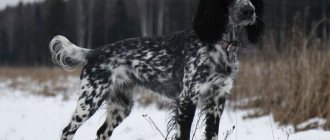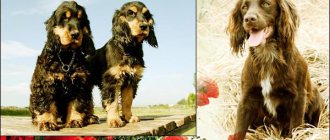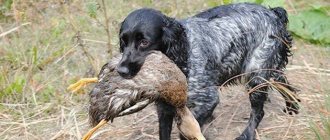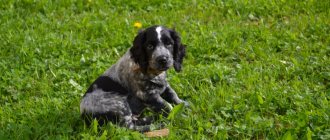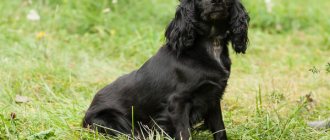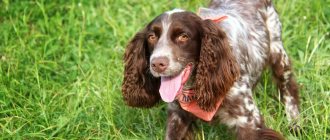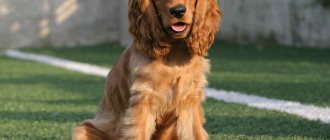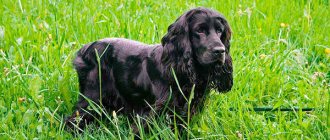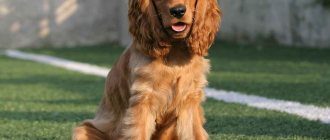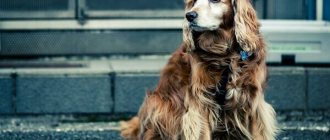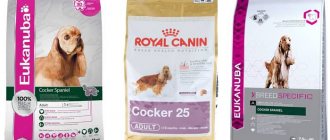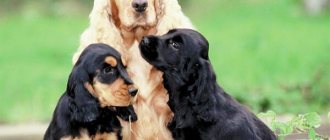Cocker spaniels include two breeds of spaniel type dogs: American And English Cocker Spaniel.
This breed was originally bred as a hunting dog in the United Kingdom. In the United States, she was bred to a different standard. Further physical changes in conformation and temperament were developed in the United States in the early 20th century, but both breeds have similar virtues, coat colors, and health problems, with few exceptions.
Breed characteristics
| Short description | |
| Origin: | Russia |
| Conditions of detention: | House with or without garden, apartment |
| Purpose: | Hunting dog, companion dog |
| Color: | Solid solid black, tan or chocolate brown, white markings acceptable |
| Wool length: | Long |
| Adult dog size: | Female height – 36-42 cm, male height – 38-44, weight – 15-20 kg |
| Average life expectancy: | 10-12 years |
| Walk: | Need active walking twice a day |
| Physical activity needs: | High physical activity needs (1.5-2.5 hours of walking or training) |
| Classification of the Russian Cynological Federation (RKF): | Group 8: Retrievers and Gun Dogs, Section 2: Gun Dogs |
| Puppy price: | From 3,000 to 20,000 rubles. Without pedigree – 3000-5000 rubles, pet class – 10000 rubles, breed class – 15000 rubles, show class – 20000 rubles |
Nutrition
Dogs are “eternally hungry animals” - this popular expression very accurately describes the Russian Spaniel breed. But the diet should be rich in vitamins and minerals necessary for the development of a healthy dog.
Especially at a younger age, as puppies grow and need proper nutrition. If the new owner does not have enough time to prepare food, you can use ready-made food.
The owner’s primary task is to carefully monitor the volume of portions and their relationship with the dog’s physical activity. Otherwise, it will lead to obesity and its negative consequences.
Puppies of this breed should have 4-5 meals a day, with a time interval of at least 3 hours. You need to gradually accustom your dog to feeding twice a day (morning and evening).
Clean water must be constantly available to the animal. It is also important to keep an eye on the bowls and regularly pour boiling water over them.
Expert opinion
Anna Abramenko
An avid dog lover. Experience in veterinary medicine since 2009.
Ask a Question
The list of foods that dogs of this breed should not eat: river fish, seasonings and spices, fatty or smoked meat, fresh baked goods, sweets, legumes.
Authorized products:
- vegetables and fruits in season;
- ground bones;
- dried (stale) bread;
- lungs or stomach;
- intestine cuttings;
- legs, wings;
- sea fish without bones;
- rice, oatmeal or buckwheat cereals;
- cartilage;
- beef, rabbit, turkey or chicken meat;
- kidneys, heart, liver;
- kefir, low-fat cottage cheese, milk.
It is important to cook the intestines or stomach well so that the dog does not contract gastrointestinal infections. Before eating, it is enough to scald the meat, twist it into minced meat for very small puppies, and for 7-8 month olds it can be cut into small pieces.
Expert opinion
Anna Abramenko
An avid dog lover. Experience in veterinary medicine since 2009.
Ask a Question
It is advisable that the dog eats its entire portion, but if this does not happen, then the remaining food must be removed and the portion size reduced for subsequent feedings.
Spaniel hunters are given boiled waste from the hunt, so that later, when catching, the dogs do not tear the game.
History of the origin of the species
The idea to develop a new hunting breed came to Russian breeders at the end of the 19th century, when European Spaniels, which were good at hunting, but were not suitable for the climate, began to be imported into the country. Active work began, the long-legged Cocker and Spring Spaniels were crossed.
The Russian Spaniel is considered one of the youngest Russian hunting breeds. The breed took its final form in the mid-20th century; a standard was developed in 1951 1966 . But before this, the breed line was not perfect. Dogs no longer resembled their ancestors, but still did not constitute a single new type. Since 1972 , dogs are no longer modified.
The animals are still not recognized by the International Canine Organization, although in Russia they are highly valued for their versatility. Russian spaniels hunt any feathered game, hares and small fur-bearing animals.
Notes
- ↑ 1,01,1 Parshev A.P., Rusina I.B. “Historical sketch of the early history of the Russian spaniel”
- Russian Hunting Spaniel Breed Standard (RKF 2020)
- The Sporting magazine / January 1858
- Evening Post / December 21, 1891
- Evening Post / September 8, 1899
- Auckland Star / 23 March 1929
- Rusina I.B. “Russian hunting spaniel: past, present, future” / Dog Friend Magazine No. 8, 2011
- Russian Spaniel Club
- Russian hunting spaniel Breed standard (1966)
- Russian Hunting Spaniel Breed Standard (Project 2000)
- Russian Hunting Spaniel Breed Standard (Project 2015)
Distinctive features
This breed is medium-sized, well-built, with a strong body and well-developed muscles. A feature can be considered long hair and variability of colors. At the withers, the animals reach 36-44 cm, and weigh from 15 to 20 kg.
Spaniels are stretched in structure. Their body length is slightly greater than their height. Their limbs are quite long, which makes them adaptable to running through swamps or snowdrifts. The latest standard was published in 2012.
- The head is dry and long. The skull is oval, with a pronounced smooth stop and brow ridges.
- The muzzle is moderately long, narrow (tapering towards the nose), filled in under the eyes. The jaws are strong but soft, with a full set of teeth and scissor bite The lips are thin and pigmented.
- The nose is wide with open nostrils.
- The eyes are medium-sized, oval, not widely set. The color of the iris depends on the coat color: from light brown to dark brown.
- The ears are set at eye level, long, thin, adjacent to the cheekbones;
- The body is streamlined and strong. The back is long and wide. The loin is slightly convex. The croup is sloping. The withers are pronounced. The chest is deep and well descended. The neck is of moderate length, dry, muscular. The belly is tucked in.
- The tail is a continuation of the croup, moderately long, carried at the level of the back or slightly above it. It is docked by half, unless it is prohibited in the country.
- The limbs are dry, straight, parallel, the hind legs are set wider than the front ones. The paws are oval with gathered toes, characterized by the presence of hair between them. Movement : light gallop.
- The coat is straight or wavy, moderately long, close-lying and shiny. Lengthening is noticeable on the ears, limbs, abdomen, chest and neck.
- Colors: solid, bicolor or tricolor in various variations.
Cupping
There is no clear point of view regarding this topic. Previously, this procedure was considered mandatory, because the dog could damage its tail while hunting. But, over time, the breed began to be purchased more often as pets or for participation in exhibitions.
In this regard, there is no longer any urgent need to dock dogs' tails, because at home or at an exhibition the chances of damaging them are low. If, after all, the purpose of purchasing a Russian Spaniel puppy is to help in hunting, then it is advisable to dock its tail in the first 2 days of life.
During this period, the operation is as painless as possible, the baby loses a little blood, because at the age of several days the blood flow in the tail of dogs has not yet had time to develop as it should.
Older puppies are given local anesthesia during the procedure, and at the end the wound is sutured and bandaged. As a rule, the tail is cut by half or 3/5 of the length.
Photo of an adult dog
Diseases and life expectancy
In spaniels, most health problems are not genetic in nature, but most often there are ailments caused by improper care or nutrition of the dog, or the environment.
The most common diseases:
- otitis – inflammation of the ear inside and outside, which can occur due to insufficient hygiene;
- obesity – occurs when the relationship between nutrition and activity is incorrect;
- conjunctivitis - an inflammatory process in the eyes;
- food allergies – can be to various foods;
- dermatomycosis – skin fungus (fur falls out, irritation throughout the body);
- leptospirosis - the infection enters the animal’s body from stagnant bodies of water, and if you do not respond in time, the dog may die (fever with jaundice, the disease affects internal organs);
- ringworm.
The average lifespan of the breed is 10-15 years. But a dog can live longer if it is provided with appropriate care and nutrition.
Photos of puppies
Features of character and behavior
The Russian Spaniel is an excellent pet and companion. He is active, friendly and devoted to his owner. The breed has not lost its hunting qualities and still serves people.
These dogs are characterized by intelligence and ingenuity, independence in decision-making, good reaction, and endurance. All these qualities become indispensable in the forest.
Advantages
The breed was bred for hunting, so it has a full range of necessary physical qualities:
- Acute vision and sense of smell;
- Energy;
- Endurance;
- Resistance to cold and dampness;
- Strong skeleton and developed muscles.
Animals learn quickly and understand all commands.
Russian spaniels love their family, get along with children, and listen to their owner. They will be happy to serve a person, spend all their time with him: lying on the couch or climbing into a cold swamp. They like to run with their owner, play with family members, and bring toys. These dogs are very active and remain playful almost into old age.
They get along well with other pets and livestock. They communicate well with both dogs and cats, despite the fact that they are hunters.
Flaws
- Spaniels can be stubborn, intractable, and often try to dominate.
- They really need good upbringing and a firm hand, otherwise they will grow up to be an uncontrollable pet.
- They are real destroyers: they love to gnaw, break, tear, scratch. Everything that lies badly will be picked up, studied and spoiled by this pet.
- They cannot serve as guards. Representatives of the breed are friendly and do not see danger in humans. Besides that, they just bark.
- They are gluttonous and have no sense of proportion. This makes walking much more difficult. If the bad habit of picking up from the ground was not eliminated during puppyhood, then you can forget about walking without a leash.
- They can be aggressive towards other people's children and do not like noise, shouting and bullying.
Pros and cons of the breed
Among the advantages of the breed are:
- chic appearance;
- activity;
- the ability to find a common language with any owner and with children;
- ease of education and training;
- kindness;
- positive;
- ability to get along with cats and other dogs.
Disadvantages of the breed:
- regular thorough grooming;
- the need for long active walks;
- predisposition to obesity;
- not suitable as a security guard.
Care and maintenance
These dogs can be kept both indoors and outdoors. They feel comfortable in various conditions and can tolerate any temperature. Of course, like every hunting dog, the Spaniel will be happy to spend all his time outside, where he can chew, sniff, and search.
If you plan to keep an enclosure or kennel, then you need to provide the dog with warm bedding and a strong canopy that will protect it from sunlight and precipitation. The puppy will also need a tray for the primary toilet, toys and bowls on stands.
Apartment housing is no different from street housing, but the dog will need less food. You need to choose a place for your pet that is free from sunlight and drafts; the closer to the owner, the better.
In general, these animals are unpretentious. They do not require careful care, they eat what they give. But they need to be provided with frequent regular walks, exercise and brushing.
Nutrition
Spaniels are hunting dogs that need a lot of energy and strength, so their nutrition must be complete. More and more breeders prefer dry food, despite its bad reputation. The fact is that finished products are much easier to store and use, they contain a complex of necessary substances for dogs, in addition, separate lines have been developed for active and sedentary, sick pets, allergy sufferers, pregnant and lactating bitches.
Poor quality food may contain unnecessary substances that complicate digestion, have a negative effect on organs, and contribute to excess weight gain. Spaniels are suitable for premium holistic (grain-free) food for active medium-sized breeds.
We recommend that you read a detailed article on the topic: “How and what to feed a dog: types and characteristics of nutrition.”
These pets are prone to obesity, so the amount of food should vary depending on the activity of the animal.
On average, an adult spaniel needs 400-600 grams of food diluted with water per day. In summer, the portion is reduced, and in winter it is increased. Puppies up to 3 months are fed 5-6 times , up to 6 months - 3-4 times , and by the year they switch to two meals a day.
Usually the nursery gives advice on keeping and feeding the puppy. The breeder recommends a specific type and brand of food, the one the dog was fed before purchase. If the owner is planning a transition, then this should be done smoothly: feed the pet with the products included in the composition or choose a similar food.
For this breed, you can choose natural feeding. It is healthier and better absorbed, and the owner knows what exactly he is giving to the pet. The downside is the time spent and the inconvenience of storage and use.
The basis of the menu of such a diet should be protein:
- Lean meat;
- Dairy products;
- Boiled sea fish without bones;
- Eggs.
Don't forget about carbohydrates: grains, cereals. The dog must be accustomed to vegetables and fruits.
The menu should not include:
- Butter;
- Legumes;
- Starchy vegetables and fruits;
- Bones;
- Pork;
- Citrus;
- Flour and confectionery products;
- Smoked, fried and fatty.
Your pet's food should be of medium temperature and medium consistency. Puppies are given more food than adults. From 5-6 months you can give large pieces for chewing. Mixing dry and natural food is not allowed .
Low-fat cheeses and special treats from the pet store are suitable as treats.
It is important to maintain a drinking regime. In summer, the volume of water needs to be increased. It is important not to forget to take a container of drink for a walk.
Health
This breed can be considered truly Russian. Its representatives are not afraid of frost, work and changes in living conditions. These Spaniels are in good health, they live from 10 to 12 years , with ideal care 13-14 years . But like all long-haired, long-eared hunting breeds, they are prone to skin diseases, ear problems and digestive problems.
In addition, dogs are at particular risk of contracting an infectious disease. Therefore, you should not neglect vaccination.
Vaccinations
Hunting dogs are in dire need of vaccination because they deal with wild animals, which are often carriers of diseases. Even if the dog is not walked, vaccinations must be done, since a person can carry viruses on his clothes.
Vaccination does not provide 100% protection against infections, but it prevents their development and helps the pet recover from infection. Unfortunately, unvaccinated puppies will die if they become ill.
Usually the nursery does the primary vaccinations, and the breeder prepares the necessary documents, including a veterinary passport. The owner will be informed of the vaccination schedule that must be followed.
- The first procedure is carried out when the puppy reaches 2 months . At this time, the immunity given to him by his mother stops working. The drug is complex and contains a vaccine against major infectious diseases, such as plague and leptospirosis.
- The vaccination is repeated at 2.5, 6, 12 months and annually.
- The second important vaccination is against rabies. The drug is administered to a seven-month-old puppy. The procedure requires annual updating because it loses its effect. This vaccination is considered the main one for exporting an animal abroad.
Two weeks before vaccination, the dog must be dewormed. Before the procedure, the pet’s temperature is measured; the normal value (37-39°C) should not deviate.
Vaccination is carried out by specialists at equipped points. In case of an allergic reaction, the animal is given an antidote. If negative side effects occur for more than a day, you should consult a doctor.
The cost of vaccination depends on the weight of the pet and the percentage charged by the veterinary clinic. Usually it varies from 400 to 1000 rubles.
Important article on the topic: “Everything you need to know about dog vaccinations.”
Diseases
Health problems that are most common in this breed include:
- Skin diseases: dermatomycosis (lichen), piroplasmosis (a disease carried by mites), demodicosis (mites getting into hair follicles), sarcoptic mange (scabies);
- Diseases of the digestive system: obesity, allergies, indigestion;
- Inflammation of the ears, otitis media;
- Epileptic seizures.
Walk
This breed is extremely active. Dogs show it both at home and on the street.
With insufficient training and physical activity, the Spaniel will destroy the house: gnawing, breaking, carrying furniture and things. An adult dog needs an active walk twice a day for 1.5-2 hours.
Walking can begin after the second vaccination. The puppy is carried out in their arms and introduced to nature. After 2-3 weeks, you can learn to walk on a leash. Small dogs are walked 3-4 times a day for 20 minutes. They must get used to their environment and strangers.
The next step of socialization is getting to know other animals. Spaniels get along well with dogs and love to play with them, but the owner should always focus the pet's attention on himself. The puppy should know that it is always more interesting with a person.
The final stage will be walking the animal in noisy, crowded places . This is necessary so that the adult Spaniel is not afraid of sharp sounds, large moving objects, or passers-by. An unsocialized dog can become timid or aggressive.
For an adult pet, hunting will be an excellent walk and exercise. If it is not possible to organize a real one, then you can take the dog to the forest or planting, where it can show all its best qualities.
Spaniels make good partners for running and other sports activities. They love to play ball, fetch sticks, and chase bicycles.
Grooming
In caring for a Spaniel, the following main points can be distinguished:
- Combing must be done at least 2-3 times a week, and during seasonal shedding, daily combing with a stiff brush is required;
- bathe your pet no more than 2-3 times a year; the coat of these dogs has a protective barrier against pollution and does not emit unpleasant odors;
- If the pet is not a show pet , haircuts are allowed (2-3 times a year);
- After walks and when heavily soiled, dogs are wiped with a damp towel and their paws are washed under warm water;
- The ears are considered the weak point of all Spaniels; they are poorly ventilated due to their specific shape; they must be examined daily, checking for the presence of inflammatory processes;
- Teeth are checked twice a week, brushed with special pastes or chewing cords;
- The claws usually grind down on the asphalt; if they grow too long, they require trimming with a nail clipper once a month;
In the warm season, treatment against fleas and ticks using shampoos, solutions, powders or a collar is mandatory. Every 2 months a deworming procedure (cleansing from worms) must be carried out.
Russian hunting spaniel
Andrey Parshev and Irina Rusina, 2011 The Russian hunting spaniel, the only national breed of gundog, celebrates its 60th anniversary this year. In 1951, a breed standard was approved, which, with minor changes, is still in effect. Cute eared dogs hunt and live with us, not like other spaniels, nor cockers, nor our rare springers. The ROS are larger than the first and smaller than the second, and in general the differences are clearly visible at first glance. How did this breed appear?
In recent years, new books and publications have been published, and the Internet has entered our lives. Pedigrees and catalogs of English dog shows up to the 19th century are posted on the Internet. And now we are getting closer to unraveling some of the mysteries that fill the history of our breed.
And she, history, is interesting not only in itself. Knowing it, we will better understand what motivated the creators of this unique breed, how and why the idea arose to have our own breed of gun dogs, different from others, and most suitable for our conditions. Was the formation of the breed spontaneous or purposeful?
Yes, there is an opinion that the Russian spaniel was formed after the war, in the 50s, spontaneously, from different types of imported specimens, by mechanical mixing of cockers and springers. And it is quite common, although it is not substantiated in any way, and moreover, it is completely incorrect. It is enough to open the first volume of the All-Union Pedigree and Breeding Book of Hunting Dogs, and we will see in the photographs given there of spaniels born in the mid-30s, completely indistinguishable from the modern ROS.
The outstanding Soviet dog handler A.P. Mazover wrote: “Mating of cocker spaniels brought from abroad with dogs of the old type, preserved in the USSR in purity since pre-revolutionary times, as well as targeted selection and selection for productivity, contributed to the formation of a somewhat different type. Dogs of this type have a stronger constitution, are less decorative, have shorter ears, and coarser, less hairy coat. Dogs are most suitable for hunting in our conditions. The Soviet standard for this breed was approved based on this type.”
It is clear that the “type” was formed before the appearance of the standard, and, obviously, not after the war (the standard was prepared in 1949, and approved, according to our good tradition, only 2 years later). The beginning of its formation actually dates back to the pre-revolutionary period.
Although the name "spaniel" means "Spaniard", no traces of spaniels have yet been found in Spain, and this group of breeds originated in England. The English kings Charles I and Charles II (17th century) were great lovers of spaniels and contributed to their spread in the country.
From about this time, English spaniels occasionally came to Russia, but the name came later than the dogs themselves; In our country they were usually called “Charlots” or “Charlottes” - after the French form of the name Karl, or “dogs of the Spanish breed”, as Turgenev defined the heroine of his story Mu-mu. Even L.P. Sabaneev, a recognized authority in hunting literature, in an article of 1878 writes about spaniels literally like this: “three breeds of small setters - cockers, springers and clumbers, which we do not have at all,” although he also mentions the use of “charlottes” "on the hunt, "to which they are very inclined." At the end of the 19th century, spaniels appeared in our country under their real name.
Pre-revolutionary spaniels are often considered decorative, since the niche of gun dogs at that time was filled by cops, who literally flourished in old Russia. But in reality, everything was completely different.
Spaniels first appeared in Russia on hunting grounds that belonged to the royal family. Their first owner was Grand Duke Nikolai Nikolaevich the Younger, uncle of the last Russian Tsar Nicholas II, military and statesman. He was also the organizer of the hunting industry, the head of hunting societies and the owner of the famous Pershin hunting, which became famous for hounds and greyhounds. Nikolai Nikolaevich was seriously involved in the acclimatization of various types of game; he owned the Znamensky pheasant farm (the royal residence of Peterhof), where, following the example of aristocratic hunts in Western Europe, pheasant hunts were held. Actually, for these particular hunts, as L.P. wrote. Sabaneev, and then spaniels were used throughout Europe.
In 1885, at an exhibition in St. Petersburg, Nikolai Nikolaevich showed a black cocker spaniel, Dash. He was probably purchased from one of the English breeders, Burdett or Boulton. It is difficult to say more precisely, since the pedigrees of the Grand Duke’s spaniels have not been preserved, and the nickname “Dash” was very common at that time, since that was the name of the favorite spaniel of Queen Victoria of England. In 1888, Nikolai Nikolaevich already exhibited a flock of spaniels (at English exhibitions there was such a category - a flock (“team”) of 3 spaniels).
In the same year, 1888, a small edition of a brochure by the French author E. Bellecroix “Hunting with Spaniels” was published (the translator hid his name under a pseudonym), which spoke about the diverse use of spaniels, alone and in a group.
Since their appearance in our country, spaniels have proven to be suitable for hunting not only in pheasant hunting parks.
The magazine “Nature and Hunting” by Sabaneev published notes about the experience of hunting with them in the early 90s by the famous pointer breeder E. Novitsky. Purchased by him initially, apparently, as retrievers, the spaniels, new to us, turned out to be convenient for independent hunting of ducks, field and swamp game, especially corncrake, woodcock, and, in Southern Russia, wild pheasant. Spaniels of that time were vocal when picking up game, especially in thickets; they had a not very fast search, good presentation and excellent work on the water.
Then the spaniels were acquired by the highest ranks of the Imperial Hunt - His Majesty's Huntsman V.R. Ditz and the head of the Imperial Hunt, His Serene Highness Prince L.B. Golitsyn. Dietz's spaniels "Randolph" (showed in 1894) and "Irene" are the oldest documented ancestors of modern Russian spaniels.
Spaniels were imported almost exclusively from England, although they were already bred in continental Europe. The following breeds appeared in the exhibition catalogs of the English Kennel Club until the beginning of the 20th century: “clumbers” (clumbers, clumbers) - large yellow-piebald dogs with a quiet search, bred with infusion of Saint Bernard blood; "Sussex" (brown spaniels); "Cockers" were the only breed that had size restrictions; their weight could not exceed 25 pounds (11 kg 300 g); and the most numerous are simply “spaniels”. According to the description of the famous breeder of that time, Farrow, these were large spaniels of various colors; they also appear under the names “field spaniels” (in the sense of “field, hunting spaniels”), or even “English spaniels.” At that time, these names were synonymous. Actually, these were all spaniels weighing more than 25 pounds (11.3 kg) that were not Sussex or Clumber.
The “spaniels” of the 19th century did not subsequently disappear, but were included in new breeds - black field spaniels, English and Welsh springer spaniels, which appeared at English shows and field trails later. Obviously, the “spaniels” that came to Russia also entered the gene pool of the Russian hunting spaniel.
All of the above breeds do not exactly correspond to modern ones, even if they are of the same name; During the 20th century, all breeds changed greatly to suit changing tastes. In general, the adoption of standards for various spaniel breeds began in England only in the 20th century. Therefore, we call dogs of earlier times Cockers or Sussexes only conditionally - when they were imported into Russia, these breeds had not yet been standardized even in the originating country.
At Russian dog shows of the early 20th century, in addition to cockers, clumbers and springers, the simple spaniel breed was preserved - by the way, the most numerous. In photographs and images of that time, these are mostly red-piebald, rather large dogs.
And by the beginning of the 20th century, there were already a lot of spaniels in Russia - their massive import to St. Petersburg and Moscow, mainly from England, was noted by L. Sabaneev already in the 90s of the 19th century. Spaniels began to be bred here too - a section for “spaniels born in Russia” appeared at exhibitions. Organizationally, the spanielists of that time were affiliated with ROLFIT, the Russian society of fox terrier and dachshund lovers, whose president was the same His Serene Highness Prince L.B. Golitsyn. Spaniels participated in exhibitions of this society.
They belonged mainly to aristocratic hunters, starting with the family of the Tsar himself; several dozen spaniels were exhibited at annual exhibitions in St. Petersburg (mostly) and Moscow. This time also included an increase in the number of pheasant hunting parks, of which there were especially many around St. Petersburg, but they were all over the country, on large estates, and there were also pheasant parks for commercial hunting. It is interesting to note that, despite the lack of protection and feeding, the introduced pheasant remained in the vicinity of Leningrad until 1927.
It is still difficult to say how field competitions for spaniels were held, but, in any case, there was a category of “field winners” among spaniels at the 1913 exhibition.
The First World War caused great damage to dog breeding throughout Europe, and here we added two more revolutions and a civil war. Many spaniel owners emigrated. The imperial and grand ducal hunts were nationalized by the Provisional Government, and due to the economic crisis they were liquidated; the dogs were sold at auction. But among the dogs put up for auction on October 3, 1917, there were no spaniels, as well as some other breeds - setters, burrows. They obviously “dispersed hands” among “their own” - employees of the Imperial Hunt and the Palace Department.
When peaceful life began to improve again, spaniels again appeared at exhibitions - in 1924 there were 10 of them at the Leningrad exhibition, slightly less than before the revolution.
They were, as a rule, without pedigrees, but often with good conformation. Some of them, as has now been established, belonged to owners who were related to the Palace Department before the revolution. A number of dogs with documents have also been preserved. The Irish judge Hislin, who conducted an examination of spaniels in the ring in 1929, noted that the Leningrad stock “...is distinguished by dry, well-designed heads, elegant heads, free energetic movements, strong pads...”.
The new democratic law on hunting (the right to hunt was separated from the right to land) expanded the circle of hunters with dogs. It turned out that for the mass Russian hunter the spaniel is extremely convenient, although it does not have a stand - it does not take up much space in the home and is easy to transport in public transport. The popularity of the breed and the demand for it began to grow. This was facilitated by the promotion of spaniels by famous writers - M.M. Prishvin (4 of his spaniels are known) and V.V. Bianchi (3 spaniels). The children's book “Tomka” by the writer and artist E.I. Charushin about a spaniel puppy was, without exaggeration, known to every child of the Soviet Union. The famous Leningrad sculptor N.F. Valdman (4 spaniels, including exhibition champions) made ceramic figurines of dogs, which served as models for mass production.
Since pre-revolutionary times, the public organization “Society of Blood Dog Breeding Lovers”, OLPS, has operated in Leningrad since pre-revolutionary times. Among its leadership were world-class specialists, international experts. Members of the OLPS created the Handsome cooperative kennel, famous for its black pointers, but also engaged in spaniels. In 1923, OLPS was transformed into the Leningrad Regional Society of Blood Dog Breeding - LOOKS. These societies were engaged in improving the existing livestock, including spaniels.
An active and organized group of spanielists was formed in LOOKS (chairman D.L. Shwede). They were the first to conduct field tests of spaniels in the USSR (in 1929), which were then carried out regularly until the Great Patriotic War, and served as a model for tests and competitions in other cities of the country.
The Moscow population of spaniels was smaller and consisted mainly of cockers.
LOOKS enjoyed government support, had a good material base and a good budget, and even access to foreign currency. And in 1927, an important event took place for our breed: for LOOKS, a black and piebald speckled breeder, Alba von Blumenthal, was purchased in Germany. It is often called a “semi-springer,” but this is not entirely true (more on that later). He came from the dogs of the famous von Streserland kennel of the breeder Hans Heinrich Graf von Strachwitz. Before the First World War, his kennel was called “Darling” and was based on the line of cockers of the famous English breeder Richard de Courcy Peel (Boulder kennel). The cockers of R. de Courcy Peel were little similar to modern cockers and were very reminiscent of ROSov. The fact is that at the end of the 19th - beginning of the 20th century, this retired military doctor, along with other famous breeders Phillips and R. Lloyd, opposed the Kennel Club (the national canine organization of Great Britain) on the main issues of the development of the cocker spaniel breed . Their alternative organization, the Spaniel Club, championed the concept of relatively larger dogs, above the Kennel Club's 25-pound limit. To obtain such lines, these breeders used the infusion of blood from other breeds - including English setters. Such methods were not particularly advertised, but in nursery conditions they were possible, and we know about them from the book of G.S. Lloyd, the son of R. Lloyd.
The spaniels of the Spaniel Club now have a previously unseen color, in English “blue roan”. Among setters it is called “blue-belton”, among spaniels it is called “black and gray non-contrasting with specks”, briefly “black and piebald with specks”. For the Russian hunting spaniel it is almost the main one.
R. de Courcy Peel's kennel "Bowdler" has produced several English show champions, the most famous of which are Rufus Bowdler, his maternal brother Bob and Bob's father Ben Bowdler. And not only exhibition ones. The 1908 English Field Championships (then held for all spaniel breeds together) were won by Rufus's daughter, Walhampton Judy. Prices for grown-up puppies from Rufus at the beginning of the 20th century were 120-160 pounds sterling, while Purde's gun cost 60-120 pounds at that time (the then pound sterling was equal to approximately 7 grams of gold), mating your dog with it cost 3 pound. Ben and Bob Bowdler were valued about the same as Rufus.
These dogs are found in Alba’s ancestors, in the 6th-8th generations, and more than once, in total they provided Alba von Blumenthal with more than half of their blood.
Unfortunately, no photographs of Alba von Blumenthal have yet been found, but it is known that his exterior served as a model for the development of the post-war breed standard. A few years later, LOOKS acquired a second male in Germany, Caesar von Schmich, who also descended almost entirely from Bowdler dogs, partly through the kennel of Count von Strachwitz, partly through other European kennels.
This fact proves that the LOOKS breeding sector was focused on a very specific type of spaniel and was well versed in the lines that existed at that time. Caesar was even more intensely attached to Bob Bowdler than Alba.
Both males were not only actively used for breeding, but strong inbreeding was carried out on them - they both mated with their descendants. As a result, the now famous Soviet breeding spaniels of the 30s - 40s carried 30-75% of the blood of Alba and Caesar, while the rest of their gene pool came from pre-revolutionary spaniels, which were also not bad.
In Leningrad, breeding work with spaniels was led by the well-known dog handler S.P. Miklashevsky even before the revolution, translator of Laverack’s book on breeding the English Setter breed. Miklashevsky himself is better known as the owner of Irish setters, one of which, Boy, was the “face of the breed” and was depicted as such in the illustrations of all pre-revolutionary books (the standard of the Irish setter was also translated by Miklashevsky).
Also, simultaneously with Alba, abroad, in Belgium (in the Antwerp kennel Hannekar), the cocker Sammy of Wezemel, a repeated winner of Belgian exhibitions, was purchased as a sire - a representative of a different line, whose ancestors came from G. Lloyd's kennel "of Ware" ). Sammi belonged to the hunting section of the influential sports society OGPU Dynamo and was registered in Lubyanka. Active spanielists in Moscow in the 20s-30s were M.K. Mamontova and D.L. Yaroshevsky, owners of spaniels of Leningrad and St. Petersburg origin, who left a noticeable mark on our breed. From their dogs, as well as from Brown N.N. Fetter, come Jolly 1/s and Jenny 2/s - the first spaniels registered in VRKOS.
At the end of the 30s, LOOKS turned into a large supplier of purebred dogs of various breeds for the entire Soviet Union; spaniels were massively exported from there to Moscow, which even caused complaints from Leningrad spaniel owners about the lack of puppies. But, as it turned out later, the breed was thereby saved.
The Second World War almost completely destroyed the breeding center in Leningrad. Almost all pre-war spaniels died at the front or died during the blockade. Only 7 spaniels survived in Leningrad, of which only two were born before the war, recorded in the All-Union Pedigree and Stud Book. But thanks to the descendants of the LOOKS spaniels, the formation of the breed was continued in Moscow.
In 1945, a spaniel section was formed in Moscow at the MOOiR. It was headed by the famous expert V.T. Dmitrievsky. The Leningrad organization was also restored, and A.S. Lyubosh became its chairman. By this time, despite the presence of breeding material, the breed as such did not yet exist. There was an attempt to establish a standard for the "Cocker Spaniel" in 1925 and 1939, but it was unsuccessful. The developers of the standard were guided by cockers of the late 19th century, such as the founders of this breed, Obo and Bob Obo, whose height was 25-31 cm, and set a maximum height of 35 cm. Our spaniel did not meet these restrictions - our population was significantly larger.
During the war and shortly before it, the standard of the cocker spaniel, which had previously been extremely vague, was finally concretized in the USA and England, and its own standard was developed for the USA, and its own for England. They now have height restrictions (the upper limit for a male dog is 40.6 cm, and in the USA it is even less). These standards did not suit us.
As a result of vigorous debate between supporters of the small and large spaniel, the second point of view won, and in 1949 the breed standard was first developed, which is still in effect with changes, with a height for males of 38-45 cm. Therefore, in the West, our spaniel is often considered a springer, although there are practically no springers among the ancestors of ROS.
Before the war, the Moscow livestock was too small, but by the end of the 40s its growth was increased due to strong inbreeding on Alba and Caesar. A significant role in this was played by Charlie 4/s Dmitrievsky V.T (son of Caesar and grandson of Alba) and Handsome-Hum D.A. Yaroshevsky (son of Alba), which were brought from Leningrad. Both of them carried more than half the blood of Alba and Caesar, and actively mated, including with their descendants. But for some reason the offspring of the Moscow black cocker Sammi von Wesemel bred very little, apparently, they did not fit into the new standard.
Although in the post-war years there was an influx of breeding material of hunting dogs from Europe into the country, there was no comparison with the situation, for example, with German pointers. Until 1951, only 6 export dogs were recorded in the stud book; almost all spaniels registered in the VRKOS were descendants of pre-war Soviet ones, and the percentage of Alba + Caesar blood averaged about 50%.
At this point, spaniels were quite of the same type, as can be seen from the descriptions and surviving photographic materials. The main color was black and piebald, or more precisely, the same non-contrasting black and piebald with specks - up to 70% of the livestock had this color. There were also a number of coffee piebalds, and - sporadically - tri-colored, black, red piebald and golden ones. All these colors were found among the ancestors of Alba and Caesar.
In the 1950s, imports from Europe increased significantly. These were both purchased there by our military personnel, and requisitioned in Germany by the state commission under the leadership of A.P. Mazower. The dogs exhibited in the rings at that time were of different sizes, the color options were varied, and not all had complete pedigrees. But at that time the standard was already in effect, and only those who fit it were allowed to breed. Imported spaniels were included in auxiliary stud books, and those checked for the quality of their offspring were included in the All-Union (later All-Russian) pedigree and stud book. But they no longer significantly influenced the gene pool of the Soviet population, since none of the post-war spaniels were used as intensive breeders as Alba or Caesar, much less close inbreeding was used. Therefore, in recent decades, the diversity that arose in the 60s has been able to be “brought to a common denominator” again. Most likely because closely inbred sires produced offspring “in themselves” and easily “bleeded” dogs unrelated to them.
However, the breeding stock was replenished with some interesting dogs. Littermates Zorka Akchurina and Pirate Bobrova were brought from Austria from the famous Mayerpetz kennel, who descended from the famous cockers of Lloyd's kennel of Ware. The Pirate's son - part Sancho 95/s - already carried half the blood of pre-war spaniels, and further dilution only intensified. Nominally, the line of Ch. Sancho 95/s is currently one of the most common in our country; his descendants in the direct male line are in St. Petersburg and the Moscow Dynamo Island (for example, through Barey).
At the end of the 50s, Lord Brovtsina was brought to Moscow from Latvia, who, thanks to his great-grandson, became Part. Minoru N.A. Valova is the founder of another line. Its bright successor is Part Charlie III G.F. Mikhailov, possessing a bright breed exterior and working qualities, which he consistently passed on to numerous offspring. One of the famous descendants of Part Charlie III is Part Nils Romashkova, who has many descendants in Moscow and throughout the country, as well as in Ukraine. But statistically, the share of the Lord’s own blood in his current descendants is insignificant.
No other new lines were formed in the breed in the 50-60s; the main lines remained that went back to the same Alba and Caesar. And now in Moscow and the Moscow region the line ch., p.ch., ch.p. is widespread. Argus III Proshin is the champion of the breed at the turn of the millennium, a direct descendant of Alba von Blumenthal, and if you look deeper into history, then the British champion Rufus Bowdler.
The line of h. Charlie 4/c (that is, Caesar von Schmich) in the central region of Russia, unfortunately, was cut short, but his genes still make up a significant portion of the gene pool of the Russian hunting spaniel. This is how our breed began to be called after 1972; before that it was called simply “spaniel” (before the war it was called “spaniel”). In the same year, 1972, the influx of foreign breeding material stopped (before that there had been an exchange with the English Cocker breed), and the requirements for inclusion in the breeding composition were tightened.
Since the late 40s, a system of field trials and competitions has revived in the country, and breeding regulations have been adopted allowing only spaniels tested for working qualities to be admitted into the tribe. This is an important moment in the life of our breed. Until recently, genetic tests for hereditary diseases were almost unknown in our country, but the breed, nevertheless, is quite prosperous in this regard. This is partly an element of luck - our “ancestors” turned out to be, for example, free from such a phenomenon as “sudden rabies syndrome”. But this is mainly due to the constant testing of field qualities, a test that dogs with physical or mental disabilities cannot withstand, and the grading system at exhibitions, when prizes depend not only on the exterior, but also on the results in the field and the quality of the offspring.
This is how a special breed of spaniels was formed in our country, clearly distinguishable from other modern breeds with which our ROS has common ancestors.
And 60 years after the official approval of the breed, and more than a hundred years after the ancestors of Russian spaniels arrived here, both we and our long-eared friends look confidently into the future. Source: my-cocker.ucoz.ru
Mating
Dogs can be untied at the age of 20-25 months, although puberty comes much earlier (8-10 months). It is during this period that the female will go into her third heat, and a loose loop and light discharge will be a signal that the girl is ready.
To officially transport the breeding, owners need to fill out certificates and forms at the nursery. The male is selected in advance, the owners agree on the date and price, which is usually equal to one puppy or a percentage of its cost.
Pets must be checked for pathologies and diseases and undergo deworming 2 weeks before mating.
Spaniels are not large, they do not need much space. The pets are introduced, walked together, and brought to the dog’s territory. Here the boy will feel relaxed and free. If the female is calm and everything suits her, then the male will be able to make a cage. Otherwise, you need to give the dogs more time or try another day.
Sexual intercourse lasts from 10 to 15 minutes , during which time the animals are helped not to lose their balance: the girl is held under the stomach and by the head, the boy is guided into a noose. You can invite a specially trained person. In the absence of a lock, the female can be fertilized. The fixative mating is carried out after 2 days .
Read a detailed article on the topic: “Everything you need to know about breeding dogs: appropriate age, what to do if it doesn’t work out, rules and tips.”
What do English Cocker Spaniels get sick with?
Allergy
Benign tumors
Cataract
Progressive retinal atrophy
Ear infections
Hearing loss (in parti-colored dogs)
Patella dislocation
Hypothyroidism
To minimize the likelihood of a dog developing one or more of these problems, look for a breeder who can provide animal orthopedic foundation test results and eye examination results from the Canine Eye Registry Foundation for each parent.
There is also an animal hearing test that measures brainstem audiotriggered response (BAER), which may be important if you are considering a Pied English Cocker Spaniel.
Key points in training
A Spaniel puppy chooses one owner to obey. But for this, a person needs to show his leadership qualities and show the dog the existing hierarchy in the family.
In order for your pet to understand that the people in the house are the main ones, you need to teach him some habits:
- Feeding is carried out only after the whole family has eaten;
- You can enter the room only after everyone has entered;
- Walking, sleeping, and playing on human furniture is strictly prohibited.
Representatives of the breed tend to dominate. All attempts to dominate or show character must be stopped. However, crude methods will not work. Enough with a stern look, a firm word, and deprivation of treats.
The owner needs to learn not to react to begging, puppy dog eyes, and acting techniques.
Raising a dog begins from the first days of life, but training begins from 3-4 months , when the puppy remembers its name. You can contact the kennel club and take the “Dog in the City” course. It will help the dog socialize and the owner to establish contact with the animal.
For a hunting dog, it is important to unquestioningly follow basic commands:
- "Near";
- "To me";
- "It is forbidden";
- "Sit";
- "Voice".
Read about how to properly train a dog in the article: “Training a puppy: effective methods from dog handlers, learning commands at home.”
If the owner has not achieved obedience, the pet is unlikely to become a good helper. To train individual hunting skills, it is worth contacting specially trained people.
Training and education
Raising a puppy begins from the first days of its appearance in the house. By the age of six months, the pet must have mastered a set of basic commands well. Particular attention is paid to the direction - to me. The Russian spaniel is a hunter; all breeds with such skills are prone to escape. In order not to run far from the owner, having noticed a cat on the street, the dog must follow this command the first time. You can turn to dog handlers for help in cases where you want to master a specific training program with your pet. Spaniels are easy to train, so you can choose any of them. The main thing is to teach the puppy basic commands so that he has certain knowledge and skills for further study.
First of all, you need to train your pets to respond to nicknames. Popular for spaniel boys are Lucky, Mickey, Rippy, Scotch, for girls - Dolly, Tracy, Jena, Linda.
How to choose a puppy
The choice of a puppy depends entirely on the financial capabilities and wishes of the potential owner. You need to decide on the gender of your pet. Males are better suited for hunting, but they are more capricious. Bitches are usually softer and can give birth.
In addition, it is worth choosing the puppy’s class in advance. Not only the dog’s future career depends on it, but also its cost. There are 3 classes that are assigned to an animal a couple of months after birth:
- Pet class - dogs with minor deviations that do not prevent them from becoming good pets;
- Breeding class – animals with ideal external characteristics, fully complying with the standard, suitable for breeding;
- Show class - pets with a good pedigree, born champions and prize-winners, their future career is exhibitions.
A puppy can be purchased at the age of 2.5-3 months. Small dogs are easier to train and adapt to their needs. But there is a lot of trouble with them, including vaccinations and special feeding. Experienced dog breeders prefer to buy older animals (5-6 months), but in this case problems with training may arise.
A good breeder will provide a package of necessary documents, tell you about the litter and parents, and help you decide on your future pet. The kennel has the right not to sell a dog if the potential owner does not meet the criteria or is not suitable to raise the dog .
Puppies will always be playful, perky and active. Healthy dogs must be clean, meet the standard and have no obvious pathologies. The cost depends entirely on the class of the pet: from 3,000 to 20,000 rubles .
Where to buy an English Cocker Spaniel
When looking for an English Cocker Spaniel, first contact animal shelters in your area. A surprising number of purebred dogs end up in shelters due to owner problems.
If you do decide to buy a puppy from a breeder, be wary of breeders without references.
Look for reputable breeders who can provide a medical certificate from the litter's parents and detailed information about your intended puppy.
Other Breeds to Study
An English Cocker Spaniel can be your ideal pet if you do your research into the breed before making your decision. Experienced breeders and owners provide advice on training, energy requirements and more.
To learn more about similar breeds, check out their profiles:
Breton epañol (Brittany)
Cavalier King Charles Spaniel
Reviews from breed owners
Reviews about the breed are mostly positive . Owners describe Spaniels as loyal and obedient hunting dogs, but believe they are not suitable for everyone.
- The first disadvantage is excessive activity and the need for frequent long walks.
- The second is a lot of wool.
- The third is diseases.
Thus, the owner of an adult Spaniel, Irina, writes: “These pets are unpretentious in their maintenance, survive frosts well, and eat everything. Very bright both in appearance and in character. They are loving, affectionate, playful, and are completely devoted to serving their owner. Indispensable during hunting. But they need careful care, especially for ears and fur. Dogs are very active and can be destructive. Without education, they become leaders in the family.”
Another owner believes that all dogs are worthy of attention and respect, but Russian spaniels are special: “You immediately fall in love with the eyes of this pet. You may not like animals, but a dog of this breed will win your heart. Our pet is loyal, playful, active. The only genetic drawback is frequent illnesses and epileptic seizures.”
Characteristic diseases
The lifespan of an American Cocker Spaniel is from 14 to 16 years. Diseases are genetic and congenital.
Due to mistakes in training, a dog may exhibit behavioral pathologies - aggression, panicking. Dogs sometimes suffer from skin asthenia (Ehlers-Danlos syndrome). When the disease occurs, the skin loses its elasticity, sensitivity and strength.
There is a lack of carnitine, which causes the heart muscle to weaken. This causes dilated cardiomyopathy. Sometimes there is excessive inversion of the eyelid due to drying of the cornea (keratoconjunctivitis), skin infection on the extremities (pododermatitis), and inflammation in the outer ear (otitis externa).
Diseases of the intervertebral discs lead to ruptures and displacements, so there is a risk of paralysis of the dog. Puppies may have dysplasia (improper formation of the retina), and adults may have melanoma. It is a not very common type of cancer. Its development occurs from skin cells that produce melanin.
